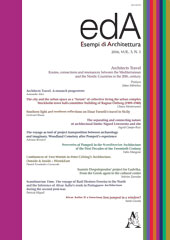Estratto da
ESEMPI DI ARCHITETTURA
International Journal of Architecture and Engineering
Ioannis despotopoulos’ project for Ludvika from the greek agorà to the cultural centre
ESEMPI DI ARCHITETTURA
International Journal of Architecture and Engineering
Ioannis despotopoulos’ project for Ludvika from the greek agorà to the cultural centre

The Greek architect Ioannis Despotopoulos (also known as Jan Despo) in 1949 receives the commissionto design the cultural centre (Folkets Hus) of Ludvika, which represents his more emblematicwork in Sweden. The project was about the realization of a complex of public buildings, including atheatre, a library and a dance hall, for this small city in the middle of the Scandinavian country.The theme of the cultural centre is not new for Despotopoulos; it represents the outcome of a series ofprojects and his unceasing research on the theme of public space and public buildings related to a culturalfunction, he elaborated in Greece and in Sweden since the thirties onwards, and their importantrole for the existence of the meaning of the city. The cultural centre in this way obtains a charactersimilar to that of the ancient agorà, which contributed as catalytic factor to the creation of the Greekpólis and became the decisive element able to transform a settlement into a city.The aim of this study is therefore to investigate how Despotopoulos drew this project and how he insertedit in the Swedish city taking into account both the local architecture and the idea of Greekagorà. The questions that raise are: how could the space and the public buildings of agorà be influentialfactors for the definition of the elements of the city? How the project dialogues with the architectureof ancient agorà with Swedish architecture and the tradition of Swedish cultural centres?
| pagine: | 83-92 |
| DOI: | 10.4399/97888548991798 |
| data pubblicazione: | Dicembre 2016 |
| editore: | Aracne |








